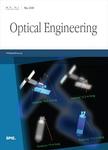版权所有:内蒙古大学图书馆 技术提供:维普资讯• 智图
内蒙古自治区呼和浩特市赛罕区大学西街235号 邮编: 010021

作者机构:German Aerosp Ctr DLR Inst Commun & Navigat Oberpfaffenhofen D-82234 Wessling Germany
出 版 物:《OPTICAL ENGINEERING》 (光学工程)
年 卷 期:2007年第46卷第2期
页 面:025003-1-025003页
核心收录:
学科分类:08[工学] 080401[工学-精密仪器及机械] 0804[工学-仪器科学与技术] 081102[工学-检测技术与自动化装置] 0811[工学-控制科学与工程] 0702[理学-物理学]
主 题:free-space optics scintillation loss intensity modulation and direct detection (IM/DD systems short-term bit error rate (BER) long-term BER channel coding
摘 要:In optical communications through the atmosphere, the evaluation of a link feasibility often requires the quantification of the scintillation penalty in terms of power loss. To find how much additional optical power is needed to reach the bit-error-rate (BER) requirements, the optical-power fluctuations must be characterized as well as the response of the receiver to those fluctuations. In the present analysis, the direct-detected optical power is assumed to be either lognormal or gamma-gamma distributed. To account for the dynamics of the atmospheric channel, a distinction is made between short-term and long-term BERs. For a simple On-Off Keying (OOK) modulation, expressions of scintillation losses are given for different system requirements. Specifically, an upper bound is set to any of the three following quantities: the long-term BER, the probability of having a too-high short-term BER, or the mean time during which the short-term BER is too high. Results show that, without any fade mitigation, losses under moderate scintillation are considerable. Finally, a simple code-word approach shows how scintillation losses can be reduced by channel coding. (c) 2007 Society of Photo-Optical Instrumentation Engineers.